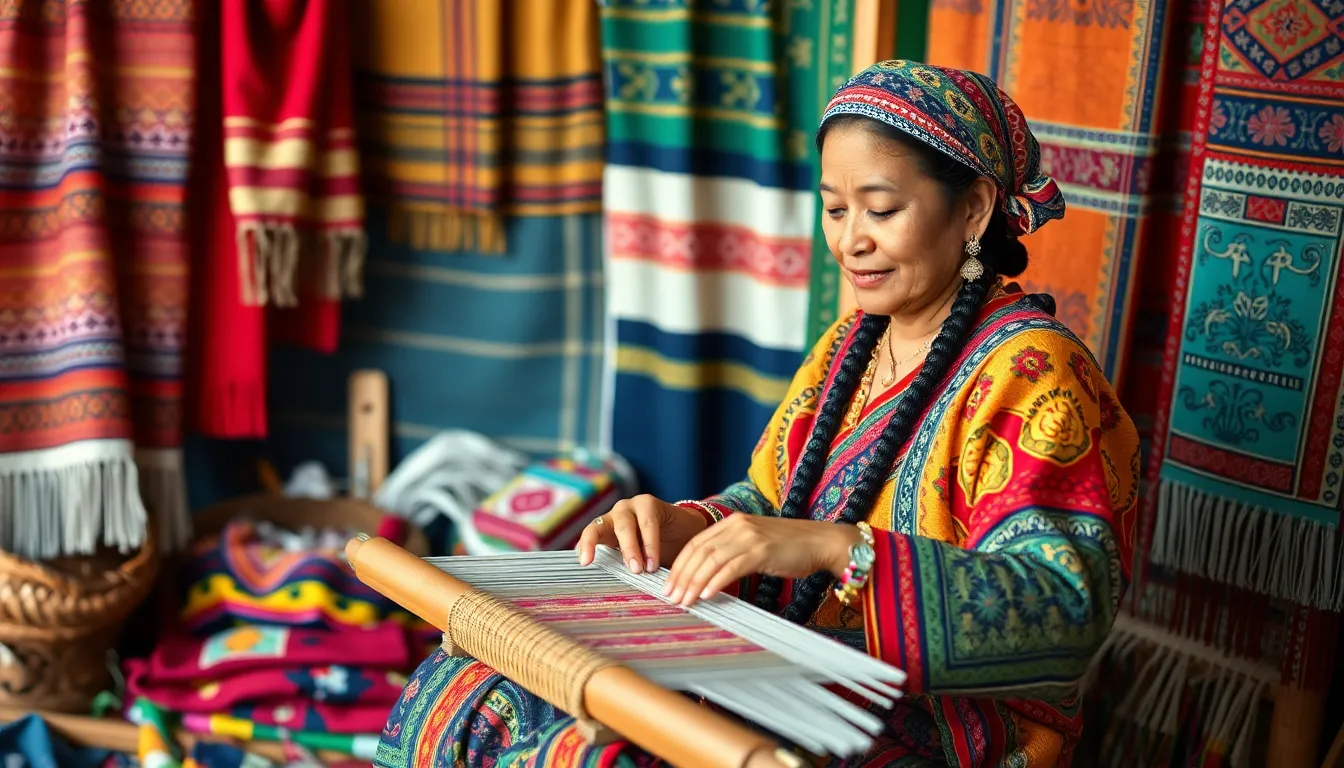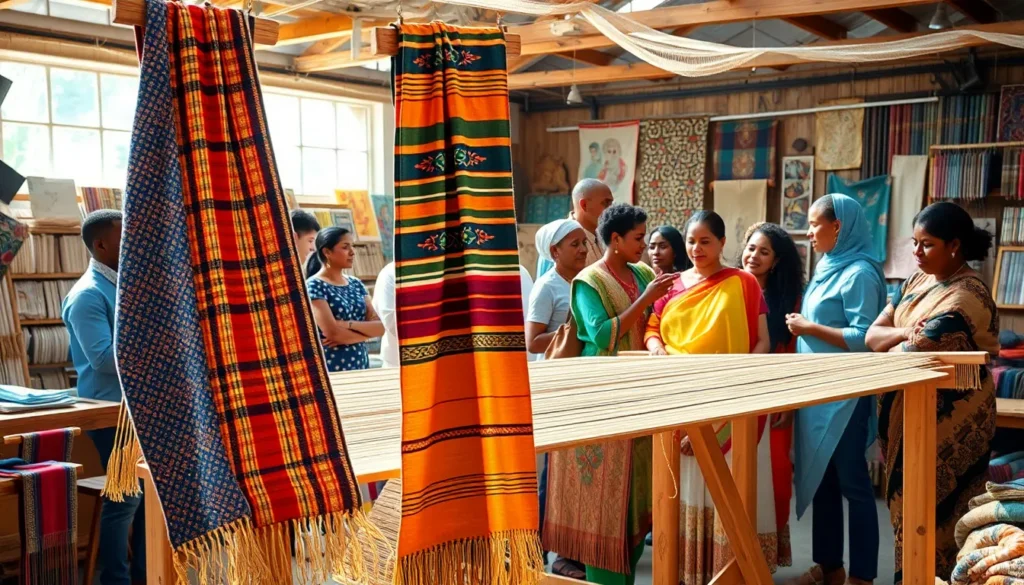Table of Contents
ToggleTextiles are more than just fabric; they’re the storytellers of culture, history, and identity. Every stitch and pattern weaves together memories that span generations, making each piece a unique tapestry of human experience. From the vibrant patterns of African kente cloth to the intricate designs of Indian saris, textiles hold secrets waiting to be unraveled.
Understanding Cultural Memory in Textiles
Cultural memory in textiles encompasses the shared beliefs and identities reflected in fabric. These materials serve as visual representations of traditions, connecting past experiences to the present.
Definition of Cultural Memory
Cultural memory refers to the collective memory shared among a group. It includes stories, customs, and values passed down through generations. Textiles act as vessels for this memory, encapsulating significant events and cultural practices. Fabrics often reflect the identity and heritage of the people who create them. Patterns and colors can symbolize specific meanings, enhancing the connection to cultural heritage.
Historical Significance of Textiles
Textiles possess deep historical significance, often influencing social and economic contexts. Traditional fabrics serve as markers of identity, indicating regional and ethnic distinctions. The production and use of specific textiles have evolved over time, reflecting changing societal values. For instance, ceremonial garments highlight important life events and cultural rituals. In many societies, textiles carry stories of migration, trade, and adaptation, underscoring their role as cultural chronicles. Artisans’ skill in crafting these materials conveys the richness of cultural narratives intertwined within the threads.
The Role of Textiles in Cultural Identity

Textiles embody cultural identity through their intricate designs and techniques. Each fabric tells a story, serving as a powerful medium of expression that conveys feelings, memories, and traditions.
Textiles as a Medium of Expression
Textiles express individual and community identities through patterns, colors, and techniques. Traditional techniques, like weaving or dyeing, reflect specific cultural narratives. Cultural anecdotes often emerge in every stitch, making fabric a visual language. Artisans use textiles to document their history, celebrating ancestors and preserving legacies. The emotional resonance of textiles connects people to their origins, ensuring history remains alive.
Regional Variations in Textile Traditions
Regional differences shape textile traditions across the globe. Fabrics like Japanese kimono or Peruvian textiles demonstrate unique cultural influences. Textiles often incorporate locally sourced materials, influencing color and texture. Communities adapt patterns and techniques to express identity, creating a rich tapestry of variety. Festivals and rituals frequently showcase these regional fabrics, reinforcing a sense of belonging. The diverse traditions highlight how geographic factors and cultural exchanges mold textile artistry.
Symbolism and Meaning in Textile Patterns
Textile patterns carry deep cultural significance, often reflecting shared histories and values within communities. Each design speaks volumes, conveying narratives passed down through generations.
Common Symbols Found in Textiles
Common symbols include geometric shapes, animals, and natural elements. Geometric patterns often represent continuity and stability, while animal motifs can symbolize strength or virtue. Natural elements, such as flowers or trees, frequently signify growth and connection to the Earth. These symbols not only enhance the aesthetic appeal of textiles but also encapsulate cultural beliefs and practices. For instance, African textiles may use certain colors to represent different social statuses, while Indigenous designs can highlight the community’s connection to nature. Through these symbols, textiles become an archive of collective understanding and identity.
Interpretation of Patterns Across Cultures
Interpretation of patterns varies significantly across cultures. Some societies may view a spiral as a representation of life cycles, while others might perceive it as a symbol of eternity. Colors hold different meanings too; red can denote joy in one culture and symbolize danger in another. Context affects interpretation, as the same pattern may convey different messages. For example, the intricate patterns of Japanese kimonos communicate harmony and respect, whereas vibrant Latin American textiles often express collaboration and festivity. This diverse interpretation enriches the dialogue around textiles, revealing the complexities of cultural identity and memory.
Case Studies of Cultural Memory in Textiles
Cultural memory within textiles manifests through various examples, showcasing stories and identities woven into fabrics across different cultures.
Indigenous Textiles and Their Stories
Indigenous textiles encapsulate narratives that connect communities to their history. Each piece, such as Navajo rugs or Maori cloaks, reflects distinct cultural practices. These textiles often incorporate symbols representing local traditions, spiritual beliefs, and environmental connections. Many artisans preserve ancestral techniques, allowing younger generations to engage with their heritage. Through vibrant colors and patterns, indigenous textiles transmit the wisdom and lived experiences of their creators. The utilization of natural dyes and practices further signifies a deep respect for the land and its resources, highlighting the relationship between culture and environment.
Contemporary Textile Artists and Cultural Narratives
Contemporary textile artists redefine cultural narratives through innovative techniques and practices. Artists like El Anatsui utilize discarded materials, transforming waste into captivating art that tells stories of consumption and sustainability. Each artwork serves as a commentary on cultural identity in modern society. Many contemporary creators draw inspiration from traditional motifs, blending them with modern aesthetics. This fusion connects past and present, allowing discussions about cultural memory to evolve. The works of these artists demonstrate how textiles continue to be a vital medium for self-expression and cultural representation in an ever-changing world.
The Future of Cultural Memory in Textiles
Cultural memory in textiles continues to evolve as new generations embrace traditional techniques while integrating modern influences.
Modern Influence on Traditional Techniques
Contemporary designers often blend historical methods with innovative practices. By utilizing new materials and technologies, artists create textiles that retain cultural significance yet appeal to modern sensibilities. Some young artisans reinterpret age-old patterns, infusing them with contemporary colors and styles. This adaptation fosters dialogue between past and present, allowing traditions to resonate with today’s audiences. For instance, printing digital designs on traditional fabrics can modernize the artisans’ craft while paying homage to their heritage. Such interactions enrich the textile landscape, ensuring that cultural memories persist while appealing to evolving tastes.
Preservation of Textile Heritage
Efforts to preserve textile heritage gain momentum as communities recognize the value of their craft. Educational programs help teach traditional techniques to younger generations, ensuring skills do not fade away. Local collectives often host workshops that encourage knowledge sharing among artisans. These initiatives bond communities, reinforcing cultural identity through textiles. Preservation also includes documenting unique patterns and techniques in digital databases, making them accessible globally. Such measures protect against the loss of cultural memory while promoting greater appreciation for unique textile traditions across diverse audiences. Through these efforts, the cultural narratives woven into textiles remain vibrant and influential.
Textiles serve as more than just functional items; they embody the essence of cultural memory. Each piece tells a story woven from the threads of history and identity. As artisans continue to innovate while honoring traditional techniques, textiles remain a vital link between past and present.
The ongoing evolution of textile artistry highlights the significance of preserving cultural narratives. Through education and community engagement, future generations will carry forward these rich legacies. Ultimately, textiles will continue to reflect the diverse tapestry of human experience, enriching lives and fostering connections across cultures.







